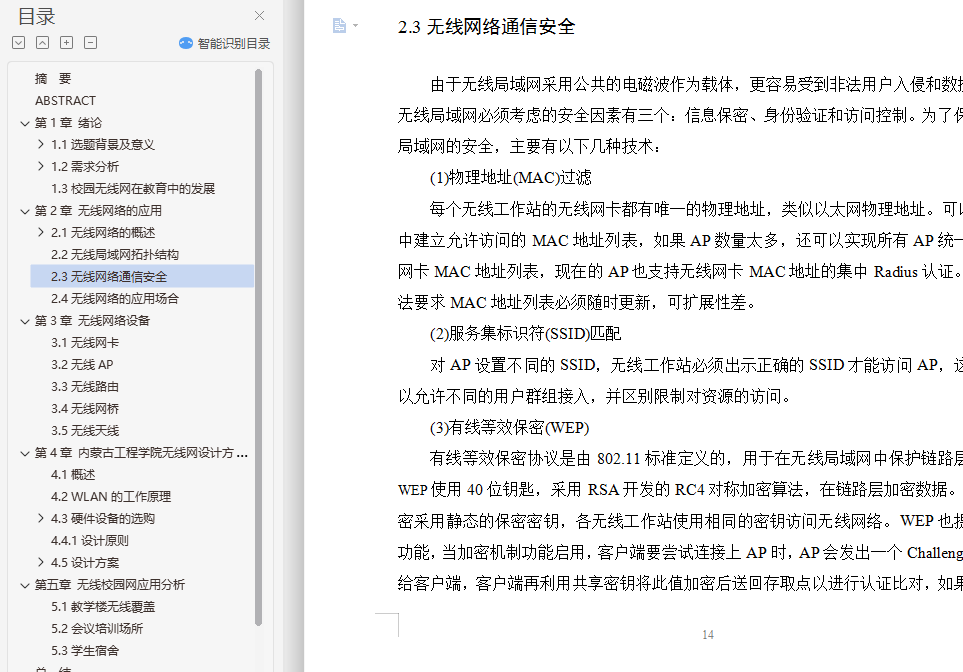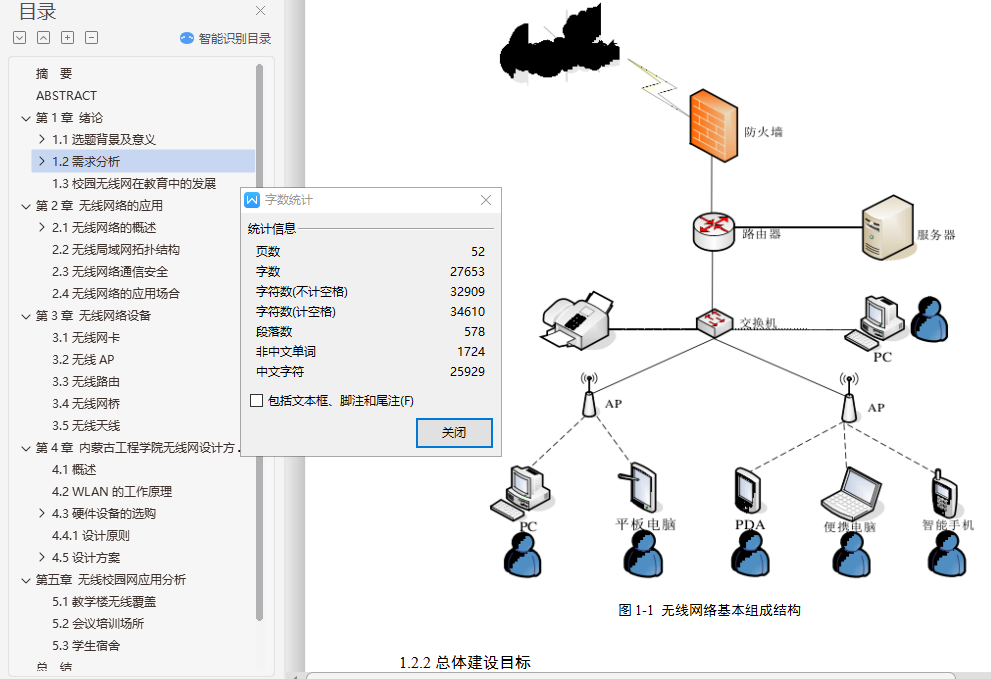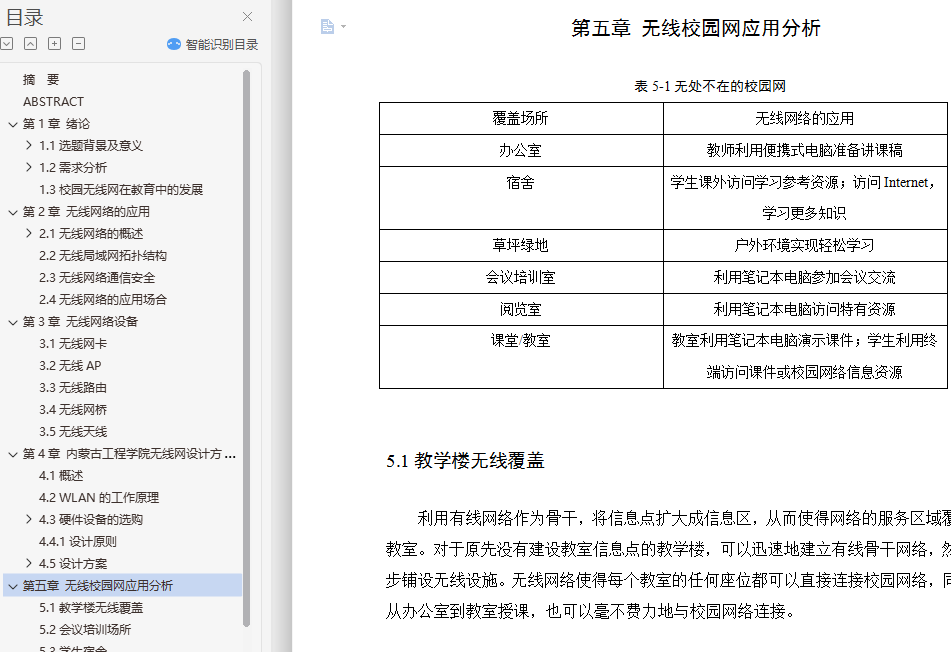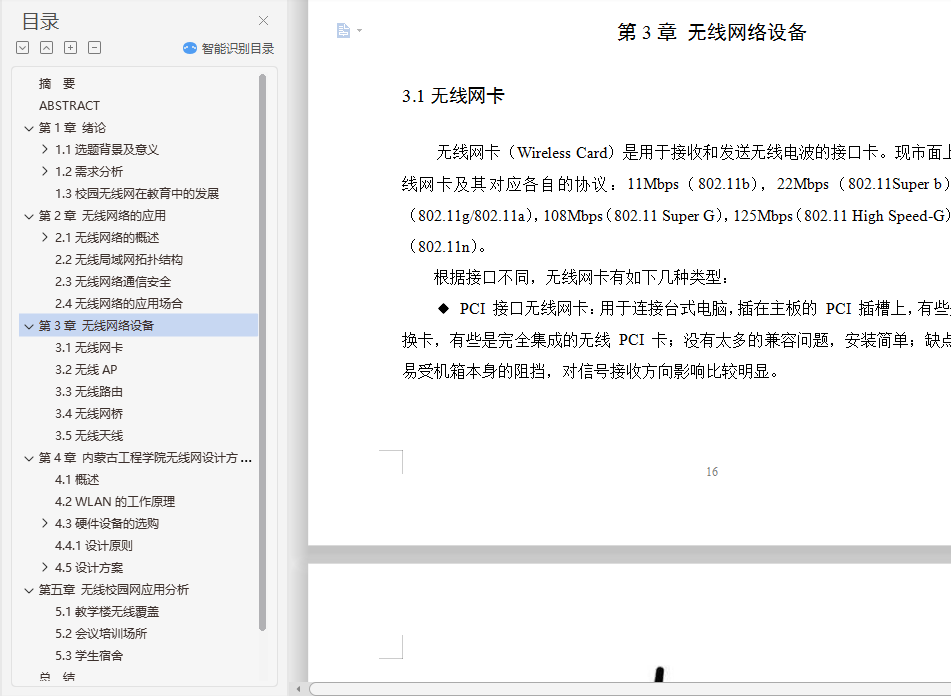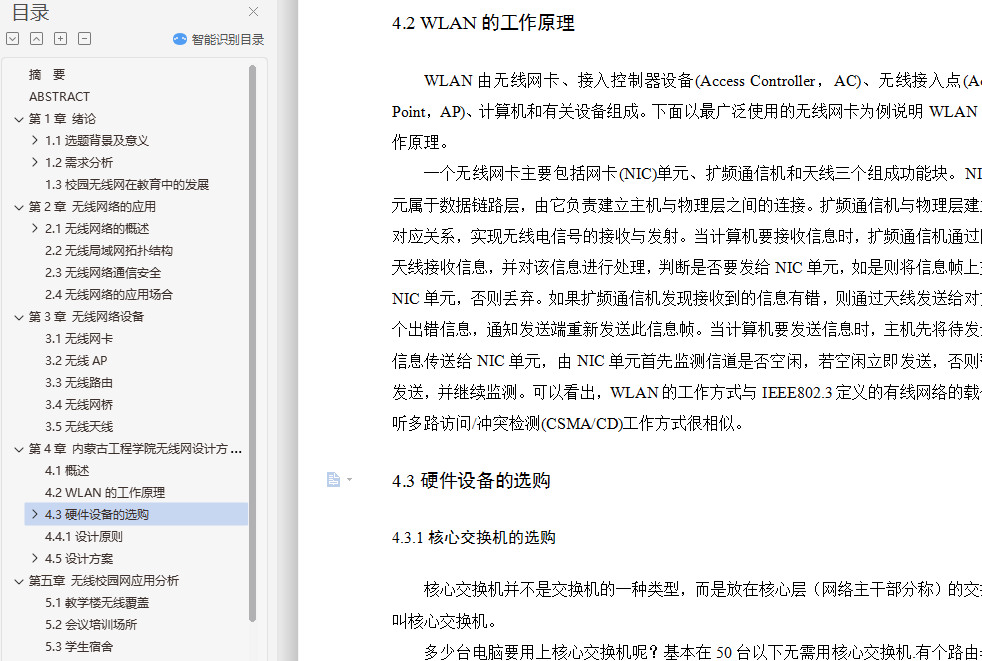摘 要
目前校园网使用在各高校已经普及,在教师和学生日常教学生活中已广泛使用,但随着无线网络的推广和应用,越来越多的教师及学生被这种随时随地能上网,不用扯长长网线的上网方式所青睐,与有线网络相比,无线网络的主要优势在于不需要布线,具有更高的灵活性,而且无线网络传输的距离更远,可以不受布线条件的限制,具有广阔的应用前景。无线网络可以让教师和学生实现教与学的时时互动,学生可以在教室、宿舍、图书馆等校园内任何地方利用移动终端机向老师问问题、提交作业;老师可以使用终端时时通过WLAN网络给学生上辅导课,学生可以利用WLAN在校园的任何一个角落访问校园网。所以WLAN可以成为一种多媒体教学的辅助手段。同时学生可以通过无线网络时时办理各种业务,比如饭卡充值、手机缴费、购买车票等,再也不用非得满世界的找网线了,WLAN网络作为构建信息化校园的一部分也起到了很好的补充。
本项目无线网络采用2.4G+5.8G双频进行覆盖,2.4G覆盖时多个信道交错使用,5.8G覆盖时相邻AP采用不相邻的信道,不同楼层之间也要考虑信道干扰问题。无线控制器AC旁挂于无线汇聚交换机, 管理流量经过汇聚交换机到达AC, AC对AP进行管理。无线控制器可以对用户进行精细的控制管理, 具备完善的RF管理和安全机制, 可以支持用户在不同AP之间进行快速漫游。无线控制器与无线网管系统和用户认证管理系统可以进行联动, 用来实现对无线用户的接入控制, 保障了网络的安全性。无线控制器采用1+1冗余部署, 可有效避免单点故障发生。PoE交换机分布在各楼层配线间, 通过万兆或千兆光链路上联无线汇聚交换机。AP通过部署在配线间的Po E交换机进行PoE供电, 采用双频放装部署, 室外AP采用全向天线的方式进行覆盖。针对不同的环境采用不同的覆盖方式, 更好地满足了用户的实际需求。
关键词:无线局域网(WLAN);校园网;设计与规划
ABSTRACT
At present, the campus network has been widely used in colleges and universities, and has been widely used in the daily teaching life of teachers and students. However, with the promotion and application of wireless network, more and more teachers and students are connected to the Internet anytime and anywhere. Compared with wired networks, the main advantage of wireless networks is that they do not need cabling, have higher flexibility, and wireless networks transmit more distance and can not be restricted by wiring conditions. It has broad application prospect. The wireless network allows teachers and students to interact with each other from time to time. Students can interact with each other in classrooms, dormitories, libraries, etc. Local use mobile terminal to ask questions to teachers, submit homework; teachers can use the terminal through the WLAN network to guide students from time to time, students can use WLAN in any corner of the campus to visit the campus network. Therefore, WLAN can become an auxiliary means of multimedia teaching. At the same time, students can always handle all kinds of business through the wireless network, such as recharging food cards, paying for mobile phones, buying tickets, and so on. They no longer have to look for Internet lines all over the world. WLAN network as a part of the construction of information campus also played a very good supplement.
The wireless network of the project uses 2.4G 5.8G dual frequency coverage, 2.4G coverage with multiple channels interlaced, 5.8G coverage with adjacent AP using non-adjacent channels, and the channel interference problem should be considered among different floors. The wireless controller AC is attached to the wireless convergent switch, and the managed traffic is managed by the AC, AC to manage the AP. Wireless controller can control the user carefully and has perfect RF management and security mechanism. It can support users to roam between different AP. Wireless Controller, Wireless Network Management system and user Authentication system The mechanism system can be used to realize the access control of wireless users and ensure the security of the network. The wireless controller adopts 11 1 redundant deployment, which can effectively avoid single point fault. The PoE switch is distributed among the distribution lines of each floor. The AP is powered by Po E switch which is deployed between the distribution lines. The PoE is supplied by dual-frequency amplifier and the outdoor AP is covered by omnidirectional antenna. The wireless convergent switch is connected on the Gigabit or Gigabit optical link. The PoE power supply is provided by the Po E switch which is deployed between the distribution lines. According to different environments, different coverage methods are adopted to better meet the actual needs of users.
Keywords: WLAN (WLAN); Campus Network; Design and Planning
摘 要 I
ABSTRACT II
第1章 绪论 1
1.1选题背景及意义 1
1.1.1选题背景 1
1.1.2选题意义 1
1.1.3国内外研究现状 2
1.2需求分析 3
1.2.1建设背景 3
1.2.2总体建设目标 4
1.2.4具体实施目标 5
1.3校园无线网在教育中的发展 6
第2章 无线网络的应用 7
2.1 无线网络的概述 7
2.1.1无线局域网络的定义 7
2.1.2无线局域网络的特点 7
2.1.3无线局域网的优势 8
2.1.4 无线局域网所存在的问题 9
2.1.5无线网络协议标准 10
2.2无线局域网拓扑结构 11
2.3无线网络通信安全 14
2.4无线网络的应用场合 16
第3章 无线网络设备 17
3.1 无线网卡 17
3.2 无线AP 18
3.3无线路由 19
3.4无线网桥 20
3.5无线天线 21
第4章 内蒙古工程学院无线网设计方案 23
4.1概述 23
4.2 WLAN的工作原理 23
4.3硬件设备的选购 24
4.3.1核心交换机的选购 24
4.3.2 POE交换机的选购 27
4.3.3服务器的选购 28
4.3.4无线路由器的选购 30
4.3.5光纤收发器的选购 32
4.4校园无线网设计分析 34
4.4.1设计原则 34
4.5设计方案 36
4.5.1主要拓朴图 36
4.5.2校园无线网络的四种典型应用及解决方案 36
4.6无线校园网络的实施步骤与应用 40
第五章 无线校园网应用分析 42
5.1教学楼无线覆盖 42
5.2会议培训场所 42
5.3学生宿舍 43
总 结 44
致 谢 45
参考文献 46
